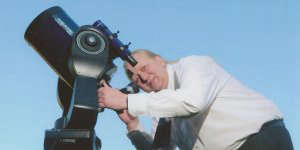
Monday 14th to Sunday 20th November 2022
The evening of Thursday 17th into the early morning of Friday 18th sees the peak of the Leonids meteor shower. By midnight on the Thursday night, the constellation of Leo the Lion will have risen above the horizon towards the east and the radiant point, where the shooting stars appear to originate from, is just above the stars marking the lion's head.

The zenithal hourly rate is around 10 meteors per hour and the fast-moving streaks of light are created by particles left from comet Tempel-Tuttle, some as small as a grain of sand, entering the Earth's atmosphere at speeds of up to 70 kilometers a second.
By 1am on the Friday morning, a 33%-lit waning Crescent Moon will have also risen above the horizon in the east and the light pollution from it will then spoil your viewing somewhat.
Officially, planet Jupiter has 80 moons orbiting around it and 57 of them have been given names by the International Astronomical Union. The four largest - Io, Europa, Ganymede and Callisto - are known as the Galilean moons because they are the ones that Galileo first saw in his telescope back in 1610. With binoculars or a small telescope, you can sometimes see all four of them, but on other occasions one or two appear to be missing because their orbit takes them behind the planet.
If you aim your telescope south east towards Jupiter just after dark, at 5.30pm on Sunday 20th, you will catch Ganymede disappearing behind the planet while Europa casts a shadow on the planet's surface as it passes in front of the gas giant.


Screenshots courtesy of Stellarium
Copyright Adrian Dening and Radio Ninesprings 2022
www.starsoversomerset.com

 Winter Coat Scheme
Winter Coat Scheme
 Recycling
Recycling
 Ilminster Local Plan
Ilminster Local Plan
 Hate Crime
Hate Crime
 False Fire Alarms
False Fire Alarms
 Dog DNA
Dog DNA
 Mobile Phones in Vehicles
Mobile Phones in Vehicles








